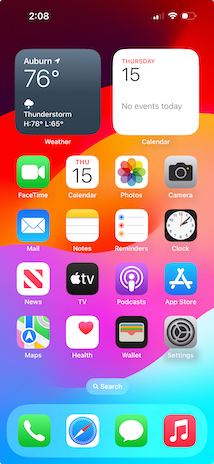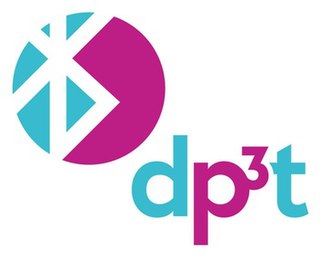
Android 13 is the thirteenth major release and the 20th version of Android, the mobile operating system developed by the Open Handset Alliance led by Google. It was released to the public and the Android Open Source Project (AOSP) on August 15, 2022. The first devices to ship with Android 13 were the Pixel 7 and 7 Pro.
Android is a mobile operating system based on a modified version of the Linux kernel and other open-source software, designed primarily for touchscreen mobile devices such as smartphones and tablets. Android is developed by a consortium of developers known as the Open Handset Alliance, though its most widely used version is primarily developed by Google. It was unveiled in November 2007, with the first commercial Android device, the HTC Dream, being launched in September 2008.

iOS is a mobile operating system developed by Apple Inc. exclusively for its smartphones. It was unveiled in January 2007 for the first-generation iPhone, launched in June 2007.
Mobile security, or mobile device security, is the protection of smartphones, tablets, and laptops from threats associated with wireless computing. It has become increasingly important in mobile computing. The security of personal and business information now stored on smartphones is of particular concern.

Android Jelly Bean is the codename given to the tenth version of the Android mobile operating system developed by Google, spanning three major point releases. Among the devices that run Android 4.1 to 4.3 are the Nexus 7 (2012), Nexus 4, Nexus 10, Nexus 7 (2013), and Hyundai Play X.
A lock screen is a computer user interface element used by various operating systems. They regulate immediate access to a device by requiring the user to perform a certain action in order to receive access, such as entering a password, using a certain button combination, or performing a certain gesture using a device's touchscreen. There are various authentication methods to get past the lock screen, with the most popular and common ones being personal identification numbers (PINs), the Android pattern lock, and biometrics.
Avare is a free open source "moving map" aviation GPS, A/FD and EFB app for phones or tablets using the Android Operating System. The app uses any internal Android or compatible external GPS receiver to determine location, allowing real-time display of location, heading, speed, distance, time, and altitude on free U.S. FAA IFR or VFR aviation charts; or on select topographic charts. Included are 3D, ADSB-In and other advanced options. The user can access all relevant static current FAA official data and some non-FAA maps and data in flight without data connection, once data has been downloaded to the device. With an aircraft ADSB-Out transmitter and inexpensive ADSB-In receiver Avare can also display any available FAA live ADSB data in flight. Some advanced users also interface Avare with an auto-pilot or flight simulator.
Android Marshmallow is the sixth major version of the Android operating system developed by Google, being the successor to Android Lollipop. It was announced at Google I/O on May 28, 2015, and released the same day as a beta, before being officially released on September 29, 2015. It was succeeded by Android Nougat on August 22, 2016.
Eddystone was a Bluetooth Low Energy beacon profile released by Google in July 2015. In December 2018 Google stopped delivering both Eddystone and Physical Web beacon notifications. The Apache 2.0-licensed, cross-platform, and versioned profile contained several frame types, including Eddystone-UID, Eddystone-URL, and Eddystone-TLM. Eddystone-URL was used by the Physical Web project, whereas Eddystone-UID was typically used by native apps on a user's device, including Google's first party apps such as Google Maps.

The BlackBerry Priv is a slider smartphone developed by BlackBerry Limited. Following a series of leaks, it was officially announced by BlackBerry CEO John Chen on September 25, 2015, with pre-orders opening on October 23, 2015, for a release on November 6, 2015.

Android Nougat is the seventh major version and 14th original version of the Android operating system. First released as an alpha test version on March 9, 2016, it was officially released on August 22, 2016, with Nexus devices being the first to receive the update. The LG V20 was the first smartphone released with Nougat.

LineageOS is an Android-based operating system for smartphones, tablet computers, and set-top boxes, with mostly free and open-source software. It is the successor to CyanogenMod, from which it was forked in December 2016, when Cyanogen Inc. announced it was discontinuing development and shut down the infrastructure behind the project. Since Cyanogen Inc. retained the rights to the Cyanogen name, the project rebranded its fork as LineageOS.

Android Oreo is the eighth major release and the 15th version of the Android mobile operating system. It was initially unveiled as an alpha quality developer preview in March 2017 and later made available to the public, on August 21, 2017.

Android 11 is the eleventh major release and 18th version of Android, the mobile operating system developed by the Open Handset Alliance led by Google. It was released on September 8, 2020. The first phone launched in Europe with Android 11 was the Vivo X51 5G and after its full stable release, the first phone in the world which came with Android 11 after Google Pixel 5 was OnePlus 8T.

COVID-19 apps include mobile-software applications for digital contact-tracing - i.e. the process of identifying persons ("contacts") who may have been in contact with an infected individual - deployed during the COVID-19 pandemic.

The (Google/Apple) Exposure Notification System (GAEN) is a framework and protocol specification developed by Apple Inc. and Google to facilitate digital contact tracing during the COVID-19 pandemic. When used by health authorities, it augments more traditional contact tracing techniques by automatically logging close approaches among notification system users using Android or iOS smartphones. Exposure Notification is a decentralized reporting protocol built on a combination of Bluetooth Low Energy technology and privacy-preserving cryptography. It is an opt-in feature within COVID-19 apps developed and published by authorized health authorities. Unveiled on April 10, 2020, it was made available on iOS on May 20, 2020 as part of the iOS 13.5 update and on December 14, 2020 as part of the iOS 12.5 update for older iPhones. On Android, it was added to devices via a Google Play Services update, supporting all versions since Android Marshmallow.

The Temporary Contact Numbers Protocol, or TCN Protocol, is an open source, decentralized, anonymous exposure alert protocol developed by Covid Watch in response to the COVID-19 pandemic. The Covid Watch team, started as an independent research collaboration between Stanford University and the University of Waterloo was the first in the world to publish a white paper, develop, and open source fully anonymous Bluetooth exposure alert technology in collaboration with CoEpi after writing a blog post on the topic in early March.

Decentralized Privacy-Preserving Proximity Tracing is an open protocol developed in response to the COVID-19 pandemic to facilitate digital contact tracing of infected participants. The protocol, like competing protocol Pan-European Privacy-Preserving Proximity Tracing (PEPP-PT), uses Bluetooth Low Energy to track and log encounters with other users. The protocols differ in their reporting mechanism, with PEPP-PT requiring clients to upload contact logs to a central reporting server, whereas with DP-3T, the central reporting server never has access to contact logs nor is it responsible for processing and informing clients of contact. Because contact logs are never transmitted to third parties, it has major privacy benefits over the PEPP-PT approach; however, this comes at the cost of requiring more computing power on the client side to process infection reports.
SwissCovid is a COVID-19 contact tracing app used for digital contact tracing in Switzerland. Use of the app is voluntary and based on a decentralized approach using Bluetooth Low Energy and Decentralized Privacy-Preserving Proximity Tracing (dp3t).
The version history of the HarmonyOS distributed operating system began with the public release of the HarmonyOS 1.0 for Honor Vision smart TVs on August 9, 2019. The first commercial version of the IoT based operating system, HarmonyOS 2.0, was released on June 2, 2021 for phones, tablets, smartwatches, smart speakers, routers, and internet of things. Beforehand, DevEco Studio, the HarmonyOS app development IDE, was released in September 2020 together with the HarmonyOS 2.0 Beta. HarmonyOS is developed by Huawei. New major releases are announced at the Huawei Developers Conference (HDC) in the fourth quarter of each year together with the first public beta version of the operating system's next major version. The next major stable version is then released in the third to fourth quarter of the following year.










